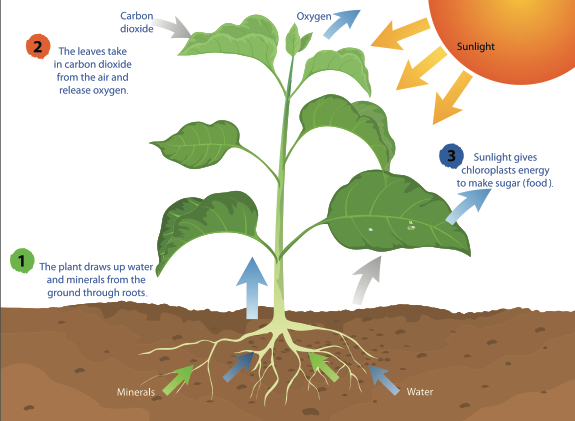what does a plant need for photosynthesis to occur
When you go hungry, you grab a snack from your fridge or pantry. But what can plants practice when they get hungry? You are probably aware that plants need sunlight, h2o, and a domicile (like soil) to grow, but where practise they get their food? They make it themselves!
Plants are called autotrophs because they tin employ free energy from low-cal to synthesize, or make, their own food source. Many people believe they are "feeding" a plant when they put information technology in soil, water information technology, or identify information technology outside in the Lord's day, but none of these things are considered nutrient. Rather, plants use sunlight, h2o, and the gases in the air to brand glucose, which is a class of sugar that plants need to survive. This process is called photosynthesis and is performed by all plants, algae, and even some microorganisms. To perform photosynthesis, plants need three things: carbon dioxide, water, and sunlight.
 By taking in water (Water) through the roots, carbon dioxide (CO2) from the air, and light free energy from the Dominicus, plants tin can perform photosynthesis to make glucose (sugars) and oxygen (O2). CREDIT: mapichai/Shutterstock.com
By taking in water (Water) through the roots, carbon dioxide (CO2) from the air, and light free energy from the Dominicus, plants tin can perform photosynthesis to make glucose (sugars) and oxygen (O2). CREDIT: mapichai/Shutterstock.com
Just like you, plants need to have in gases in order to live. Animals take in gases through a process chosen respiration. During the respiration process, animals inhale all of the gases in the atmosphere, just the only gas that is retained and not immediately exhaled is oxygen. Plants, even so, take in and use carbon dioxide gas
for photosynthesis. Carbon dioxide enters through tiny holes in a institute's leaves, flowers, branches, stems, and roots. Plants besides require water to make their food. Depending on the environment, a plant's access to water will vary. For example, desert plants, like a cactus, accept less bachelor water than a lilypad in a pond, simply every photosynthetic organism has some sort of adaptation, or special structure, designed to collect h2o. For nearly plants, roots are responsible for absorbing water.
The concluding requirement for photosynthesis is an important ane because information technology provides the free energy to make sugar. How does a plant have carbon dioxide and water molecules and make a food molecule? The Sun! The energy from light causes a chemic reaction that breaks down the molecules of carbon dioxide and water and reorganizes them to brand the sugar (glucose) and oxygen gas. Later the sugar is produced, information technology is then broken downwards by the mitochondria into energy that can be used for growth and repair. The oxygen that is produced is released from the same tiny holes through which the carbon dioxide entered. Even the oxygen that is released serves another purpose. Other organisms, such equally animals, use oxygen to assist in their survival.
If we were to write a formula for photosynthesis, it would look similar this:
6CO2 + 6H2O + Light energy → C6H12Ovi (sugar) + 6Oii
The whole procedure of photosynthesis is a transfer of energy from the Lord's day to a plant. In each saccharide molecule created, at that place is a little bit of the energy from the Sun, which the institute can either use or store for later.
Imagine a pea plant. If that pea institute is forming new pods, information technology requires a big amount of sugar energy to grow larger. This is similar to how you eat food to grow taller and stronger. But rather than going to the store and buying groceries, the pea plant will use sunlight to obtain the energy to build saccharide. When the pea pods
are fully grown, the plant may no longer need as much sugar and volition store information technology in its cells. A hungry rabbit comes along and decides to eat some of the constitute, which provides the energy that allows the rabbit to hop back to its home. Where did the rabbit's free energy come from? Consider the process of photosynthesis. With the aid of carbon dioxide and h2o, the pea pod used the free energy from sunlight to construct the sugar molecules. When the rabbit ate the pea pod, it indirectly received free energy from sunlight, which was stored in the sugar molecules in the plant.
 We tin thank photosynthesis for bread! Wheat grains, like the ones pictured, are grown in huge fields. When they are harvested, they are ground into a powder that we might recognize every bit flour. CREDIT: Elena Schweitzer/Shutterstock.com
We tin thank photosynthesis for bread! Wheat grains, like the ones pictured, are grown in huge fields. When they are harvested, they are ground into a powder that we might recognize every bit flour. CREDIT: Elena Schweitzer/Shutterstock.com
Humans, other animals, fungi, and some microorganisms cannot make food in their own bodies similar autotrophs, simply they still rely on photosynthesis. Through the transfer of energy from the Sun to plants, plants build sugars that humans consume to drive our daily activities. Even when nosotros eat things similar chicken or fish, we are transferring energy from the Sun into our bodies because, at some signal, 1 organism consumed a photosynthetic organism (e.chiliad., the fish ate algae). And so the next fourth dimension yous take hold of a snack to replenish your energy, thank the Lord's day for it!
This is an extract from theStructure and Function unit of measurement of our curriculum production line, Science and Technology Concepts TM (STC). Please visit our publisher, Carolina Biological, to learn more.
[BONUS FOR TEACHERS] Scout "Photosynthesis: Blinded by the Light" to explore student misconceptions about matter and energy in photosynthesis and strategies for eliciting student ideas to address or build on them.
Source: https://ssec.si.edu/stemvisions-blog/what-photosynthesis
0 Response to "what does a plant need for photosynthesis to occur"
Post a Comment